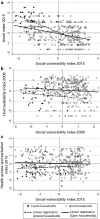Inequalities in the social determinants of health and Chagas disease transmission risk in indigenous and creole households in the Argentine Chaco
- PMID: 31029147
- PMCID: PMC6487000
- DOI: 10.1186/s13071-019-3444-5
Inequalities in the social determinants of health and Chagas disease transmission risk in indigenous and creole households in the Argentine Chaco
Abstract
Background: The social determinants of health (SDHs) condition disease distribution and the ways they are handled. Socio-economic inequalities are closely linked to the occurrence of neglected tropical diseases, but empirical support is limited in the case of Chagas disease, caused by the protozoan Trypanosoma cruzi. Herein we assessed the relationship between key structural SDHs and the risk of T. cruzi vector-borne transmission in rural communities of the Argentine Chaco occupied by creoles and an indigenous group (Qom). We used multiple correspondence analysis to quantify the household-level socio-economic position (social vulnerability and assets indices), access to health and sanitation services, and domestic host availability. We identified the most vulnerable population subgroups by comparing their demographic profiles, mobility patterns and distribution of these summary indices, then assessed their spatial correlation and household-level effects on vector domiciliary indices as transmission risk surrogates.
Results: Qom households had higher social vulnerability and fewer assets than creoles, as did local movers and migrant households compared with non-movers. We found significantly positive effects of social vulnerability and domestic host availability on infected Triatoma infestans abundance, after adjusting for ethnicity. Access to health and sanitation services had no effect on transmission risk. Only social vulnerability displayed significant global spatial autocorrelation up to 1 km. A hotspot of infected vectors overlapped with an aggregation of most vulnerable households.
Conclusions: This synthetic approach to assess socio-economic related inequalities in transmission risk provides key information to guide targeted vector control actions, case detection and treatment of Chagas disease, towards sustainability of interventions and greater reduction of health inequalities.
Keywords: Integrated vector control; Neglected tropical diseases; Social vulnerability; Socio-economic inequalities; Triatoma infestans; Trypanonoma cruzi.
Conflict of interest statement
The authors declare that they have no competing interests.
Figures






References
-
- Solar O, Irwin A. A conceptual framework for action on the social determinants of health. Social determinantes of health discussion. Paper 2 (policy and practice). Geneva: World Health Organization; 2010.
MeSH terms
Grants and funding
LinkOut - more resources
Full Text Sources
Medical

